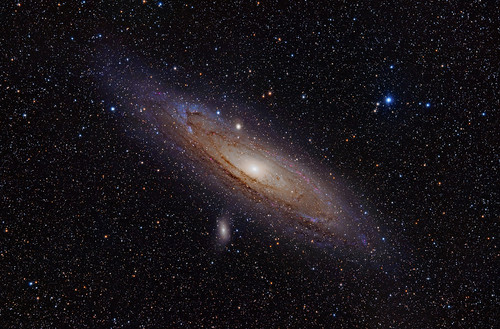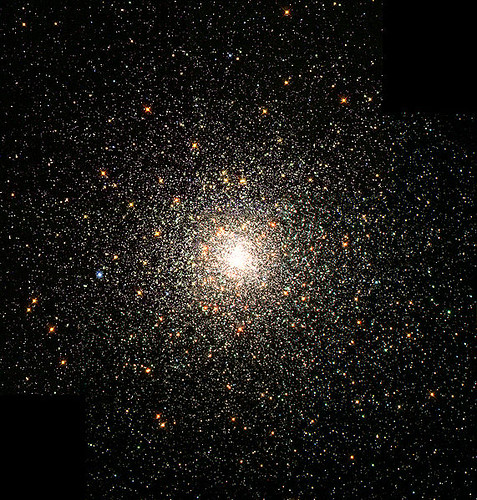What is a Galaxy?
- By Koji Mukai
- September 17, 2012
- Comments Off on What is a Galaxy?
“Galaxy,” Defined — when I came across a paper with this title while browsing a recent issue of Astronomical Journal, I was intrigued. You would think that such a widely known term, one so fundamental to modern astronomy, would have been defined a long time ago. But then, sometimes the most widely used words are the very ones that have survived without a formal definition.
More than 200 years ago, Charles Messier compiled his famous catalog to aid him in his quest to discover comets. You see, what he found there were about 100 objects that looked fuzzy, like comets, but didn’t move from night to night. Over the next century or so, astronomers gradually realized that several distinct types of objects were included in the Messier catalog. Some are nebulae, a terminology we reserve today for clouds of gas and dust that shine for one reason or another. Some are star clusters – the Pleiades, for example, is an open cluster with over 1,000 confirmed member stars that are all relatively young. Messier 15, or M15, is a globular cluster, with probably more than 1 million stars.

Hubble image of the Pleiades, credit: NASA, ESA and AURA/Caltech
Then there are what were once called “spiral nebulae.” like the Andromeda galaxy (M31). Back around 1920, some astronomers thought that every star, nebula, and cluster belonged to one system, the Milky Way galaxy. Others thought that the spiral nebulae are island universes of their own. Soon, Hubble observed Cepheid variables in M31 and showed that it was clearly outside the Milky Way. Eventually, we came to call these “galaxies.” If there were only major galaxies with spiral arms, like Andromeda and the Milky Way, then a formal definition might not be necessary – you know a galaxy when you see one.

M31, credit: Adam Evans
However, galaxies come in different shapes and sizes. Shape-wise, some have disks and spirals, some are elliptical, while others have irregular shapes (if you are interested, you can classify galaxies yourself). Size-wise, both Andromeda and the Milky Way have disks that are tens of thousands of parsecs across, or tens of kiloparsecs. However, the majority of galaxies are smaller than M31 or the Milky Way, and many orbit around a major galaxy. Globular clusters, too, orbit their host galaxies. Maybe we can use their relative sizes to distinguish between them. Most globular clusters are only few parsecs across, with a few that have sizes up to tens of parsecs. Galaxies have typical sizes of hundreds of parsecs to tens of kiloparsecs.

Globular cluster, M80, credit: NASA, The Hubble Heritage Team, STScI, AURA
The problem is, astronomers have been discovering many faint objects of intermediate sizes in recent years. So are these small galaxies or big clusters? Over the last several years, this has become a frequent topic of discussion among specialists and students alike. Some people favored size-based classification. Others focused on the stellar populations – clusters were once thought to have a single population of stars, galaxies multiple populations. But new results were blurring this line, too.
That’s where Dr. Beth Willman of Harverford College, and her colleague Dr. Jay Strader, now at Michigan State University, came in. They wanted astronomers to reach a consensus, and wrote the paper that caught my attention. I asked Dr. Willman several questions via e-mail to understand what motivated her in this work and how it fits in with the rest of their research.
Koji Mukai: Was there a specific discovery or a specific paper that motivated this work, or was it the cumulative weight of recent discoveries?
Beth Willman: Cumulative weight. The fact that “What is a galaxy?” was the most common question I was asked when giving professional talks and when talking with students. The fact that some of the most vocal contributors to the “What is a galaxy?” discussion supported definitions that Jay and I felt were insufficient to bridge the gap between galaxy observations and galaxy models – a gap that is necessary to close if we are to use extreme galaxies effectively to learn about the formation and evolution of structure in the universe. At a 2010 conference called “A Universe of Dwarf Galaxies” in Lyon, France I was reminded that there is no consensus on the answer to “What is a galaxy?” even among experts in the field. It was then that I contacted Jay and said “We do need to write this paper.”
Hence “‘Galaxy,’ Defined,” in which they proposed this definition: A galaxy is a gravitationally bound collection of stars whose properties cannot be explained by a combination of baryons and Newton’s laws of gravity.
“Baryon” is the technical term for normal matter made of atoms, the various chemical elements like hydrogen, carbon, iron and gold. So, this definition says that galaxies either have the mysterious dark matter, or we need to modify the currently accepted laws of gravity and motion. Conversely, star clusters do not have dark matter and do not need modified physics.
Koji Mukai: Once started, how long did it take you to come up with your eventual definition? Are there other definitions that you thought of but rejected?
Beth Willman: It took from Spring 2008 until January 2011 to settle on the definition. We did reject a variety of other definitions, including “An object that would be resolved as a dark matter halo in a simulation of infinite resolution” and “An object that is the primary baryonic component of a dark matter halo.” Ultimately, we wanted a definition that relied on the physical LAWS of gravity, rather than on the cold dark matter THEORY, even though our own research is conducted in a CDM context.
CDM stands for cold dark matter – the currently favored model of how universe started from an almost completely smooth state just after the Big Bang to today’s universe full of galaxies, clusters of galaxies and voids in between. In contrast, star clusters form from clumps of gas and dust in these galaxies, without the help of dark matter clumps (gas in any star cluster-sized dark matter clumps would be heated up so much, and that prevents it from becoming dense or forming stars). The hope is that such difference in the formation mechanisms will explain the different size ranges of galaxies and clusters and other observational differences in a quantitative way.
Koji Mukai: Have you seen any reactions from colleagues in your field?
Beth Willman: Not much. Maybe they are reacting on the inside :) That said, we did get a number of emails with suggestions and questions when the paper was posted on the arXiv [preprint server], so I think that the paper did catch the attention of colleagues. Perhaps because of its cheeky title!
I, for one, am glad for the cheeky title, and I do like the definition they proposed, not that I have any expertise in this field. To quote from the paper, “well-defined, well-chosen classification schemes therefore improve our understanding of the universe by facilitating meaningful comparisons between models and observations.” Let’s hope that that’s what this paper achieves.


